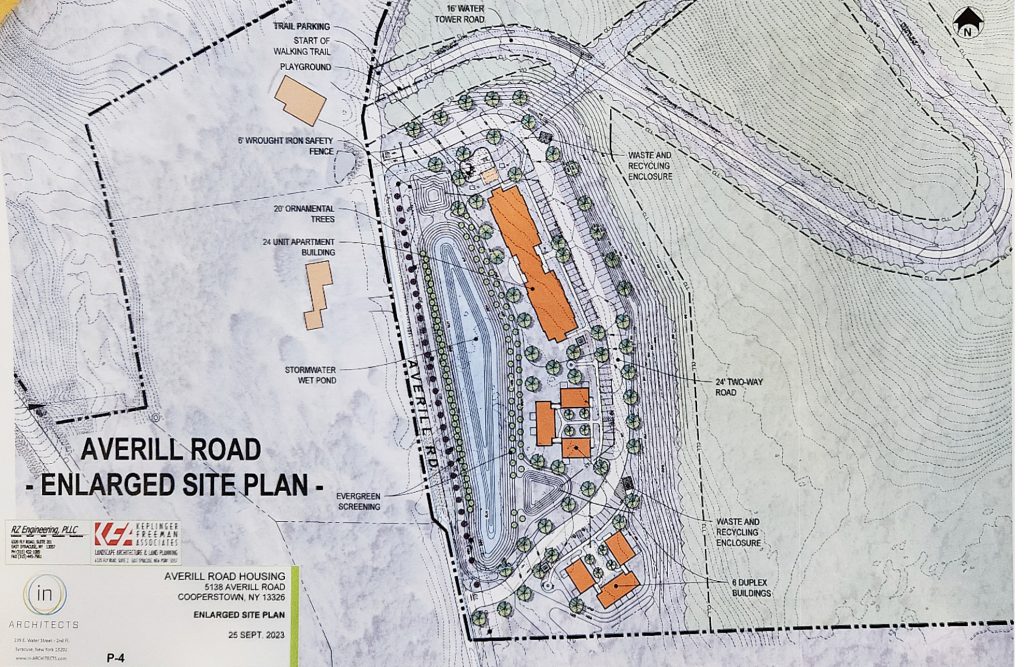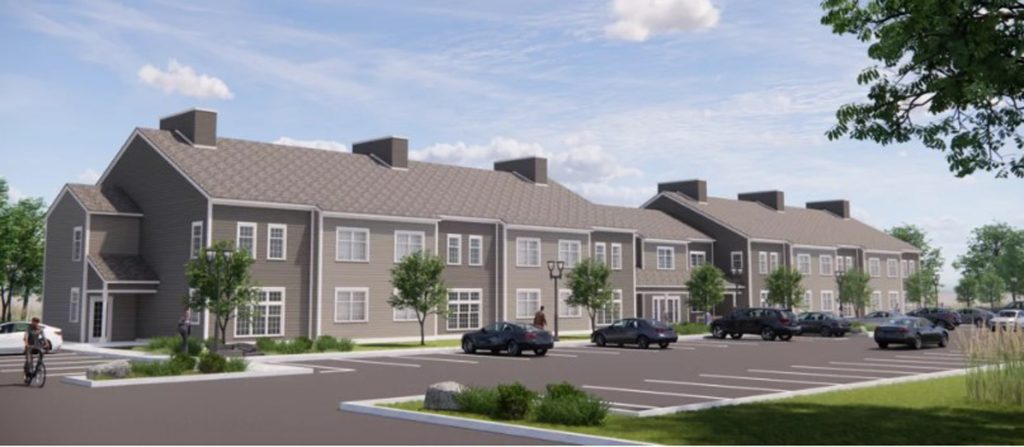
Village Reviews Application from Templeton Foundation
Averill Road Project Back for Second Look
By DARLA M. YOUNGS
COOPERSTOWN
Following two lawsuits and 90 minutes of oral argument in Madison County Supreme Court in April, Templeton Foundation has resubmitted plans for its proposed multi-residential project on Averill Road and is once again seeking the issuance of a Special Use Permit by the Cooperstown Board of Trustees.
Trustees met Monday night, September 25 to, among other actions, review materials submitted for the Averill Road project. Templeton Foundation attorney Matt Hamlin was accompanied by project team members, who gave a presentation to the board which included review of the project site plan, an overview of the housing units, and the result of work to date with the New York State Department of Environmental Conservation, New York State Gas and Electric and other entities. Aside from village representatives and the project team, only five people attended the meeting.
Hamlin reminded trustees at the outset that the project had been halted seven months ago due to a “technicality of SEQRA [State Environmental Quality Review Act] classification.” Misclassification of the project by trustees and subsequent issuance of a Special Use Permit in January led to the first of two lawsuits filed by attorney Douglas Zamelis on behalf of clients Michael Swatling and Carolyn O’Brien, who alleged that the Cooperstown Board of Trustees applied an incorrect standard when analyzing the project’s environmental impact and that the project should have been classified as a “Type 1 Action” since it is being constructed in the Glimmerglass Historic District.
According to NYSDEC, “Classification of an action as Type I requires that the review move on to the next step—determination of significance—positive or negative. Those actions identified on the Type I list carry the presumption that they will result in at least one significant adverse impact on the environment. Therefore, the likelihood of an involved agency issuing a positive declaration is greater than for other actions. A positive declaration requires the preparation of an Environmental Impact Statement.”
Hamlin said Templeton could have reapplied immediately, but “the owner made the decision—since this board has legitimate concerns—they would hold off and have the design team get answers for the board for the hard, informed look required by SEQR.”
“What we found is very positive,” Hamlin said.
“There have been no material changes to the project,” Hamlin wrote last week in an e-mail. “What has changed is that after site testing was completed, more data is now available that supports the development of the site for the multi-residential use.”
During the project presentation, various team members reviewed the Averill Road site plan, the stormwater wet pond to be installed adjacent to the road, current site conditions, the new water tower and improvements to existing infrastructure and correspondence with NYSDEC and NYSEG. Local contractor Josh Edmonds of Simple Integrity gave an overview of Passive House certification, which he said is a “great fit for a project like this.” The traditional gable shape of the housing units lends itself nicely to Passive Housing requirements, Edmonds said.

“Bassett wants to be as green as possible,” added Joseph Piraino of in-Architects, the project’s architectural design firm.
Engineer Rudy Zona addressed concerns by Zamelis and his clients regarding project compliance with the state’s stormwater regulations which precipitated the second lawsuit, filed in March in Madison County.
Both Zona and Hamlin confirmed that NYSDEC determined no Stormwater Pollution Prevention Plan was required for the project in its early stages. Trees were taken down but no roots were removed, they explained, which is not considered soil disturbance. Regardless of this determination, project leaders have proceeded with stormwater reporting as if it were required, they said.
“We have committed ourselves to being good stewards of the environment and good neighbors,” Zona said.
The planned wet pond will collect sediment and pollutants before they can discharge and regulate the flow of water coming off the property, Zona continued, which will improve the quality of water leaving the site and making its way to Otsego Lake.
“It’s a benefit,” added Hamlin.
Other concerns expressed by the trustees were with regard to traffic and electric transmission. No new substation will be needed, as per a letter from NYSEG, and the increase in traffic on the road would “not be very impactful,” according to Hamlin, though he said Templeton would very much like to widen Averill Road if permitted to do so.
The 118-page traffic impact report released in July by Passero Associates concluded: “The results of this comprehensive study determined that the existing transportation network can adequately accommodate the projected traffic volumes and resulting minor impacts to study area intersections.”
Following the presentation, trustees reviewed Part I of the SEQRA Full Environmental Assessment Form with the project team so that, as questions arose, they could be answered. At the close of the meeting, four motions were made and approved: the Village of Cooperstown was designated the lead agency for the project for the purpose of SEQRA; the project was classified as a SEQRA Type 1 Action; the application for the Special Use Permit will be forwarded to the village’s Planning and Historic Preservation and Architectural Review boards for recommendation regarding the Special Permit, and to the Otsego County Planning Department as well, due to the project’s proximity to State Route 28 and the Town of Otsego.
If the Special Use Permit is approved, Hamlin said Templeton Foundation is hoping to have hospital staff in residence at the project site by the summer of 2025.
In an e-mail last week, when asked if his clients planned to continue to oppose the project, Zamelis wrote, “My clients still have substantial concerns about transportation, drainage, visual/aesthetics, character of their neighborhood and other impacts, which we expect the Village to take a hard look at.”
As to the likelihood of a third lawsuit?
“That depends, of course, on what the Board of Trustees eventually determines. If the village were to deny the approval, my clients would not challenge the denial,” Zamelis said.





